The San Jacinto River Authority Prepares for the Future
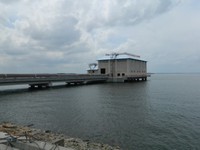 Water supply and conservation are familiar and necessary topics in Texas. The population is growing fast and the demand for water has overwhelmed many parts of the Southeast. The San Jacinto River Authority (SJRA) is working hard to conserve and protect the water resources of the San Jacinto River watershed. In order to help this cause, SJRA has begun the construction of a Surface Water Facilities (SWF) plant, which is being built on Lake Conroe, just north of Houston in Montgomery County. This project is one part of the Groundwater Reduction Plan (GRP), designed to provide treated surface water to select GRP participants throughout the county.
Water supply and conservation are familiar and necessary topics in Texas. The population is growing fast and the demand for water has overwhelmed many parts of the Southeast. The San Jacinto River Authority (SJRA) is working hard to conserve and protect the water resources of the San Jacinto River watershed. In order to help this cause, SJRA has begun the construction of a Surface Water Facilities (SWF) plant, which is being built on Lake Conroe, just north of Houston in Montgomery County. This project is one part of the Groundwater Reduction Plan (GRP), designed to provide treated surface water to select GRP participants throughout the county.
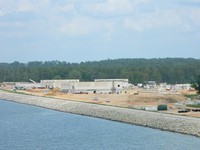 The general contractor for the SWF project, McCarthy Building Companies, Inc., chose Chamberlin Roofing & Waterproofing to provide their complete building envelope services to help construct the facility. The location of the project and its importance to the community has made this a unique venture for Chamberlin to be a part of. The project includes a raw water intake structure, a surface water treatment plant, storage tanks and a treated water pump station, to name a few.
The general contractor for the SWF project, McCarthy Building Companies, Inc., chose Chamberlin Roofing & Waterproofing to provide their complete building envelope services to help construct the facility. The location of the project and its importance to the community has made this a unique venture for Chamberlin to be a part of. The project includes a raw water intake structure, a surface water treatment plant, storage tanks and a treated water pump station, to name a few.
Chamberlin’s scope consists of installing hot-modified and standing seam roof systems, below-grade and cementitious waterproofing, building and spray-applied cellulose insulation, and joint sealants to 11 of the structures.
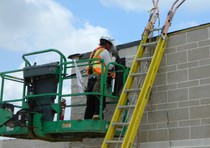
In December 2013, Chamberlin broke ground at SWF and began the hot modified roof on the High Service Pump Station. Properly managing manpower on site while multiple facilities were being built at one time was a challenge.
“Communication has been the key for managing manpower,” said Kyle Trichel, Chamberlin’s Roofing Project Manager. “I stay in contact with the roofing and sheet metal superintendents throughout the day, and coordinate with McCarthy to see what needs to be done and when the work of other trades will be completed in order to prepare for the next scope of work.”
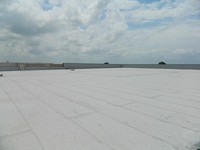
Another challenge was working on the Raw Water Intake (RWI) building that is constructed directly above water. Extra safety precautions were discussed and implemented to ensure no accidents occurred since the crews had never worked under these conditions. It was very important to not drop any tools or materials in the water because of the fact it would need to be retrieved from the bottom of the lake by divers before the pumps are turned on. In order to prevent this costly mistake, workers used lanyards to tether the tools to their harness any time they were on the RWI.
While working on the soffit panel at the RWI building’s edge, crew members were instructed to not tie off to the scissor lift, which is not standard procedure. In this instance, if the lift were to fall into the water with the workers tied to it, they would sink to the bottom with the equipment. Instead, workers are wearing life vests when working on lifts near the water. Once the roofs are complete in December, Chamberlin will have installed approximately 93,000 square feet of hot modified roofing throughout the entire project.
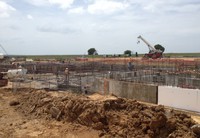
As the roof work was in progress, Chamberlin began the waterproofing scope by working on a few buildings at a time. Utilizing two crews of three workers, Chamberlin is installing a total of 17,500 square feet of below-grade waterproofing and 19,000 square feet of cementitious waterproofing on the interior face of perimeter walls. A total of 35,000 linear feet of sealant is being installed on masonry joints, exterior louvers, windows and masonry penetrations. The sealant scope also includes masonry control joints, door frames and other miscellaneous items which will prevent water infiltration to office space and areas where water testing and control equipment have been installed.
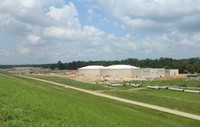
Many of the structures are being built simultaneously, but not all are at the same phase, which resulted in occasional mobilization issues at each building. To reduce equipment and material movement as much as possible, Waterproofing Superintendents, Chris Brower and Victor Lontero, coordinated with the other trades to ensure interior finishes were complete prior to scheduling sealant installation. In some cases, multiple mobilizations have been unavoidable, especially when interior equipment is ready to be installed.
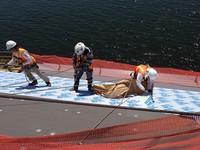
During the installation of sealants around the exterior of the RWI Building, identical to the roofing crews, waterproofers were also required to wear life jackets as further precaution from the potential of falling in the water.
Chamberlin’s work on the water treatment facility is scheduled for completion in December 2014. The owner of the facility is under their own schedule restraints as they are mandated by the Lone Star Groundwater Conservation District to reduce the ground water usage by 2016. At the current rate, all facets of the project will be ready to go well before the deadline.
Subscribe Today!
Stay-in-the-know and subscribe to our blog today!